Green Synthesis of Zinc Oxide Nanoparticles for Tetracycline Adsorption: Experimental Insights and DFT Study
Abstract
1. Introduction
2. Results and Discussion
2.1. Characterization
2.1.1. X-Ray Diffraction
2.1.2. SEM Analysis
2.2. Quality Assurance
2.3. Optimization of Specific Parameters on TC Adsorption
2.3.1. Nanosorbent Dose Influence
2.3.2. Starting TC Concentration Influence
2.3.3. Contact Durations Influence
2.3.4. pH Influence
2.4. Effect of Temperature
2.5. Adsorption Kinetic onto ZnO NPs
2.6. Isotherm Parameters for the Adsorption onto ZnO NPs
2.7. Atomistic Models of the Adsorbent and Adsorbate
2.7.1. Geometry Optimization
2.7.2. Frontier Molecular Orbital Analysis
2.7.3. Molecular Electrostatic Potential Analysis
2.7.4. Non-Covalent Interaction Analysis
3. Materials and Methods
3.1. Materials and Instrumentation
3.2. General Protocol for T. vulgaris Extract
3.3. Fabrication of ZnO NPs
3.4. Adsorption Experiments Design
3.5. Methodology Validation
3.6. Computational Statistics
4. Conclusions
Author Contributions
Funding
Data Availability Statement
Acknowledgments
Conflicts of Interest
References
- González-Ballesteros, N.; Prado-López, S.; Rodríguez-González, J.B.; Lastra, M.; Rodríguez-Argüelles, M.C. Green Synthesis of Gold Nanoparticles Using Brown Algae Cystoseira Baccata: Its Activity in Colon Cancer Cells. Colloids Surf. B Biointerfaces 2017, 153, 190–198. [Google Scholar] [CrossRef]
- Sharma, D.; Kanchi, S.; Bisetty, K. Biogenic Synthesis of Nanoparticles: A Review. Arab. J. Chem. 2019, 12, 3576–3600. [Google Scholar] [CrossRef]
- Amooaghaie, R.; Saeri, M.R.; Azizi, M. Synthesis, Characterization and Biocompatibility of Silver Nanoparticles Synthesized from Nigella sativa Leaf Extract in Comparison with Chemical Silver Nanoparticles. Ecotoxicol. Environ. Saf. 2015, 120, 400–408. [Google Scholar] [CrossRef] [PubMed]
- Kummara, S.; Patil, M.B.; Uriah, T. Synthesis, Characterization, Biocompatible and Anticancer Activity of Green and Chemically Synthesized Silver Nanoparticles—A Comparative Study. Biomed. Pharmacother. 2016, 84, 10–21. [Google Scholar] [CrossRef] [PubMed]
- Shanmugam, R.; Govindharaj, S.; Arunkumar, P.; Sanjana, G.S.; Manigandan, P. Preparation of a Herbal Mouthwash With Lemongrass and Mint-Mediated Zinc Oxide Nanoparticles and Evaluation of Its Antimicrobial and Cytotoxic Properties. Cureus 2024, 16, e53671. [Google Scholar] [CrossRef]
- Thenmozhi, T. Functionalization of Iron Oxide Nanoparticles with Clove Extract to Induce Apoptosis in MCF-7 Breast Cancer Cells. 3 Biotech 2020, 10, 82. [Google Scholar] [CrossRef]
- Mohamed, A.; Atta, R.R.; Kotp, A.A.; Abo El-Ela, F.I.; Abd El-Raheem, H.; Farghali, A.; Alkhalifah, D.H.M.; Hozzein, W.N.; Mahmoud, R. Green Synthesis and Characterization of Iron Oxide Nanoparticles for the Removal of Heavy Metals (Cd2+ and Ni2+) from Aqueous Solutions with Antimicrobial Investigation. Sci. Rep. 2023, 13, 7227. [Google Scholar] [CrossRef]
- Ishak, N.A.I.M.; Kamarudin, S.K.; Timmiati, S.N. Green Synthesis of Metal and Metal Oxide Nanoparticles via Plant Extracts: An Overview. Mater. Res. Express 2019, 6, 112004. [Google Scholar] [CrossRef]
- Altarawneh, R.M. Facile Fabrication of New Sensing Platforms Decorated with Quinalizarin and PtNi Alloy Nanoparticles for Highly Sensitive Aluminum Determination. Microchem. J. 2022, 182, 107944. [Google Scholar] [CrossRef]
- Zhang, F.; Lan, J.; Yang, Y.; Wei, T.; Tan, R.; Song, W. Adsorption Behavior and Mechanism of Methyl Blue on Zinc Oxide Nanoparticles. J. Nanopart. Res. 2013, 15, 2034. [Google Scholar] [CrossRef]
- Korkut, F.; Saloglu, D. Synthesis, Characterization, and Tetracycline Adsorption Behavior of Activated Carbon Dopped Alginate Beads: Isotherms, Kinetics, Thermodynamic, and Adsorption Mechanism. Desalination Water Treat 2020, 206, 315–330. [Google Scholar] [CrossRef]
- Fan, Z.; Fang, J.; Zhang, G.; Qin, L.; Fang, Z.; Jin, L. Improved Adsorption of Tetracycline in Water by a Modified Caulis spatholobi Residue Biochar. ACS Omega 2022, 7, 30543–30553. [Google Scholar] [CrossRef] [PubMed]
- Althumayri, K.; Guesmi, A.; El-Fattah, W.A.; Houas, A.; Hamadi, N.B.; Shahat, A. Enhanced Adsorption and Evaluation of Tetracycline Removal in an Aquatic System by Modified Silica Nanotubes. ACS Omega 2023, 8, 6762–6777. [Google Scholar] [CrossRef] [PubMed]
- Al-Tawarh, W.M.; Altarawneh, R.M.; Al-Trawneh, S.A.; Alshahateet, S.F.; Al-Taweel, S. An Effective Calix [4]Arene-Based Adsorbent for Tetracycline Removal from Water Systems: Kinetic, Isotherm, and Thermodynamic Studies. J. Chem. Res. 2023, 47, 17475198231187600. [Google Scholar] [CrossRef]
- Alshahateet, S.F.; Altarawneh, R.M.; Al-Tawarh, W.M.; Al-Trawneh, S.A.; Al-Taweel, S.; Azzaoui, K.; Merzouki, M.; Sabbahi, R.; Hammouti, B.; Hanbali, G. Catalytic Green Synthesis of Tin (IV) Oxide Nanoparticles for Phenolic Compounds Removal and Molecular Docking with EGFR Tyrosine Kinase. Sci. Rep. 2024, 14, 6519. [Google Scholar] [CrossRef] [PubMed]
- Nasiri, A.; Rajabi, S.; Amiri, A.; Fattahizade, M.; Hasani, O.; Lalehzari, A.; Hashemi, M. Adsorption of Tetracycline Using CuCoFe2O4@Chitosan as a New and Green Magnetic Nanohybrid Adsorbent from Aqueous Solutions: Isotherm, Kinetic and Thermodynamic Study. Arab. J. Chem. 2022, 15, 104014. [Google Scholar] [CrossRef]
- Gong, T.; Zhou, Y.; Sun, L.; Liang, W.; Yang, J.; Shuang, S.; Dong, C. Effective Adsorption of Phenolic Pollutants from Water Using β-Cyclodextrin Polymer Functionalized Fe3O4 Magnetic Nanoparticles. RSC Adv. 2016, 6, 80955–80963. [Google Scholar] [CrossRef]
- Gopal, G.; Ravikumar, K.V.G.; Salma, M.; Chandrasekaran, N.; Mukherjee, A. Green Synthesized Fe/Pd and in-Situ Bentonite-Fe/Pd Composite for Efficient Tetracycline Removal. J. Environ. Chem. Eng. 2020, 8, 104126. [Google Scholar] [CrossRef]
- Tcheka, C.; Conradie, M.M.; Assinale, V.A.; Conradie, J. Mesoporous Biochar Derived from Egyptian Doum Palm (Hyphaene thebaica) Shells as Low-Cost and Biodegradable Adsorbent for the Removal of Methyl Orange Dye: Characterization, Kinetic and Adsorption Mechanism. Chem. Phys. Impact 2024, 8, 100446. [Google Scholar] [CrossRef]
- Rosly, N.Z.; Abdullah, A.H.; Ahmad Kamarudin, M.; Ashari, S.E.; Alang Ahmad, S.A. Adsorption of Methylene Blue Dye by Calix [6]Arene-Modified Lead Sulphide (Pbs): Optimisation Using Response Surface Methodology. Int. J. Environ. Res. Public Health 2021, 18, 397. [Google Scholar] [CrossRef]
- Olusegun, S.J.; Larrea, G.; Osial, M.; Jackowska, K.; Krysinski, P. Photocatalytic Degradation of Antibiotics by Superparamagnetic Iron Oxide Nanoparticles. Tetracycline Case. Catalysts 2021, 11, 1243. [Google Scholar] [CrossRef]
- Zhang, A.; Li, X.; Xing, J.; Xu, G. Adsorption of Potentially Toxic Elements in Water by Modified Biochar: A Review. J. Environ. Chem. Eng. 2020, 8, 104196. [Google Scholar] [CrossRef]
- Ahsin, A.; Shah, A.B.; Ayub, K. Germanium-Based Superatom Clusters as Excess Electron Compounds with Significant Static and Dynamic NLO Response; a DFT Study. RSC Adv. 2022, 12, 365–377. [Google Scholar] [CrossRef] [PubMed]
- Asif, A.; Maqsood, N.; Akram, S.J.; Nouman, M.; Elmushyakhi, A.; Shawky, A.M.; Iqbal, J. Efficient Side-Chain Engineering of Thieno-Imidazole Salt-Based Molecule to Boost the Optoelectronic Attributes of Organic Solar Cells: A DFT Approach. J. Mol. Graph. Model. 2023, 121, 108428. [Google Scholar] [CrossRef] [PubMed]
- Costa, R.A.; Pitt, P.O.; Pinheiro, M.L.B.; Oliveira, K.M.; Salomé, K.S.; Barison, A.; Costa, E.V. Spectroscopic Investigation, Vibrational Assignments, HOMO-LUMO, NBO, MEP Analysis and Molecular Docking Studies of Oxoaporphine Alkaloid Liriodenine. Spectrochim. Acta. A. Mol. Biomol. Spectrosc. 2017, 174, 94–104. [Google Scholar] [CrossRef]
- Er-rajy, M.; Mujwar, S.; Imtara, H.; Alshawwa, S.Z.; Nasr, F.A.; Zarougui, S.; Elhallaoui, M. Design of Novel Anti-Cancer Agents Targeting COX-2 Inhibitors Based on Computational Studies. Arab. J. Chem. 2023, 16, 105193. [Google Scholar] [CrossRef]
- Lu, T.; Chen, F. Multiwfn: A Multifunctional Wavefunction Analyzer. J. Comput. Chem. 2012, 33, 580–592. [Google Scholar] [CrossRef]
- Saleh, G.; Gatti, C.; Lo Presti, L.; Contreras-García, J. Revealing Non-covalent Interactions in Molecular Crystals through Their Experimental Electron Densities. Chem.—Eur. J. 2012, 18, 15523–15536. [Google Scholar] [CrossRef]
- Orio, M.; Pantazis, D.A.; Neese, F. Density Functional Theory. Photosynth. Res. 2009, 102, 443–453. [Google Scholar] [CrossRef]
- Tomberg, A. Gaussian 09W Tutorial. An Introduction to Computational Chemistry Using G09W and Avogadro Software. 2013; pp. 1–36. [Google Scholar]
- Ayub, A.R.; Tahir, S.; Arshad, S.; Hamid, H.; Maqsood, N.; Arshed, S.M.; Iqbal, J.; Altowyan, A.S. An In-Depth Investigation of Nonlinear Optical Properties of Self-Assembled Borophene Doped with P7Ba2NO3: A Computational Simulating Study. Phys. Scr. 2024, 99, 055949. [Google Scholar] [CrossRef]
- Er-rajy, M.; El Fadili, M.; Hadni, H.; Mrabti, N.N.; Zarougui, S.; Elhallaoui, M. 2D-QSAR Modeling, Drug-Likeness Studies, ADMET Prediction, and Molecular Docking for Anti-Lung Cancer Activity of 3-Substituted-5-(Phenylamino) Indolone Derivatives. Struct. Chem. 2022, 33, 973–986. [Google Scholar] [CrossRef]
- Salah, T.; Mhadhbi, N.; Ben Ahmed, A.; Hamdi, B.; Krayem, N.; Loukil, M.; Guesmi, A.; Khezami, L.; Houas, A.; Ben Hamadi, N. Physico-Chemical Characterization, DFT Modeling and Biological Activities of a New Zn (II) Complex Containing Melamine as a Template. Crystals 2023, 13, 746. [Google Scholar] [CrossRef]
- Spivak, M.; Stone, J.E.; Ribeiro, J.; Saam, J.; Freddolino, P.L.; Bernardi, R.C.; Tajkhorshid, E. VMD as a Platform for Interactive Small Molecule Preparation and Visualization in Quantum and Classical Simulations. J. Chem. Inf. Model. 2023, 63, 4664–4678. [Google Scholar] [CrossRef] [PubMed]
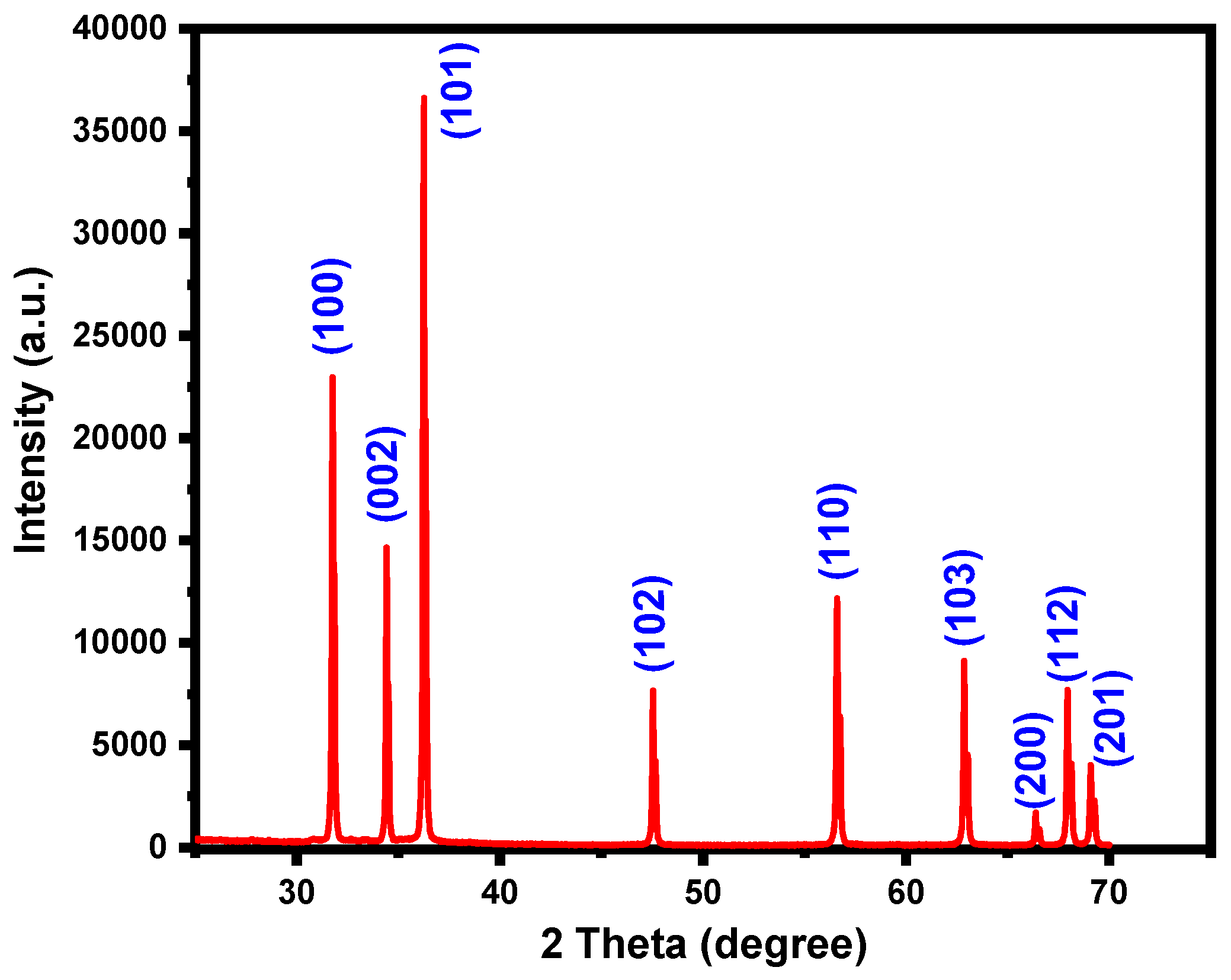
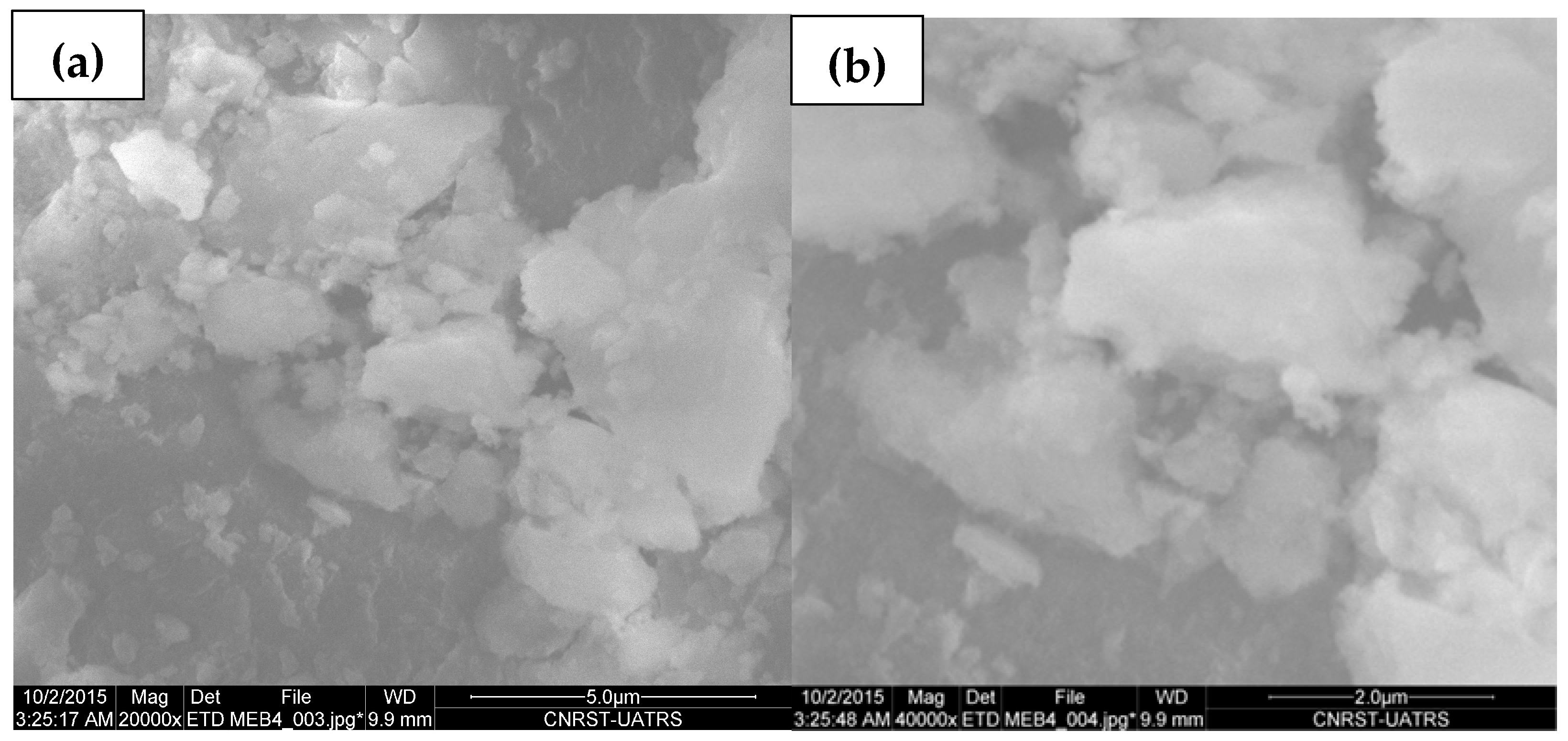
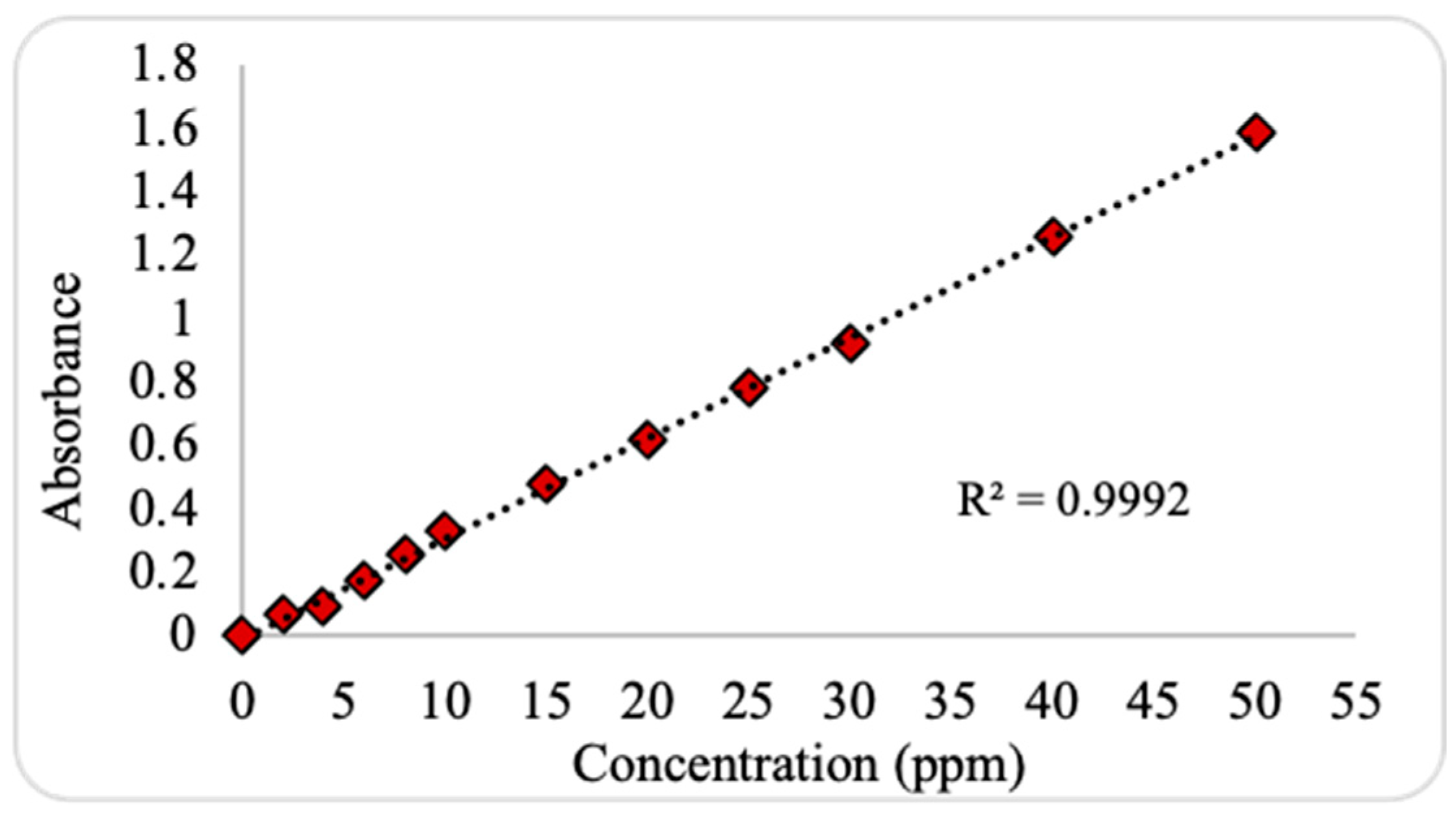


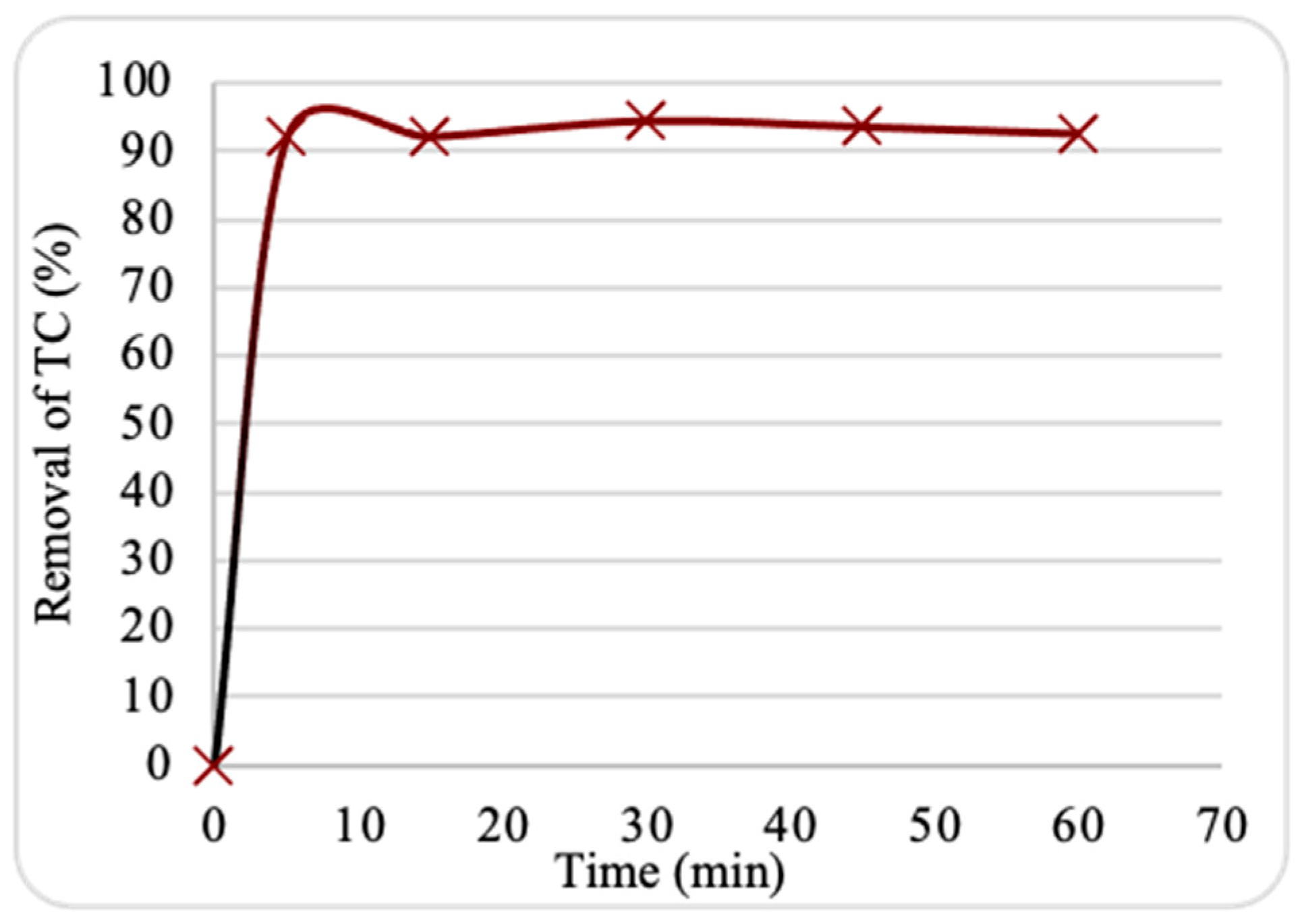
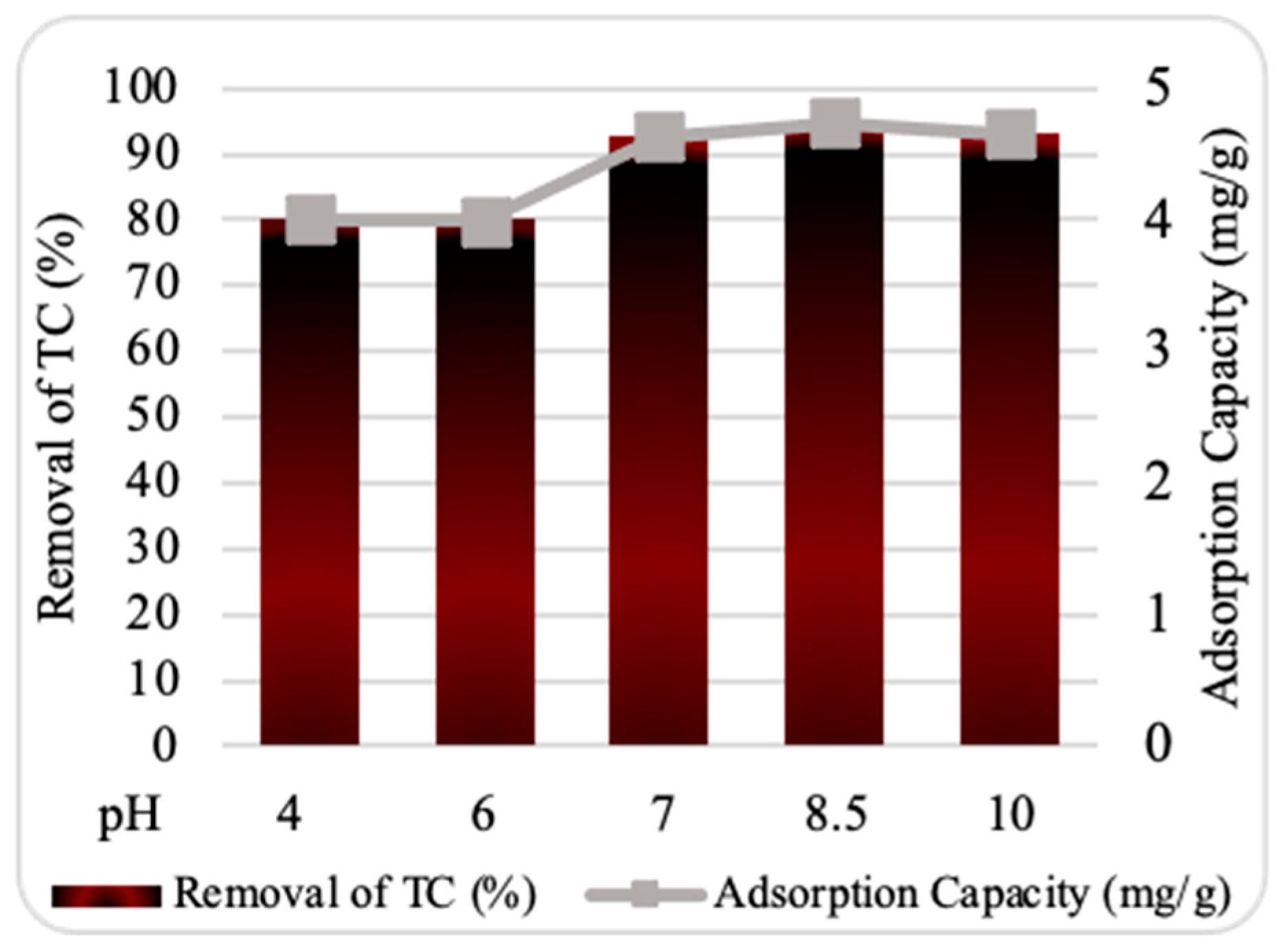

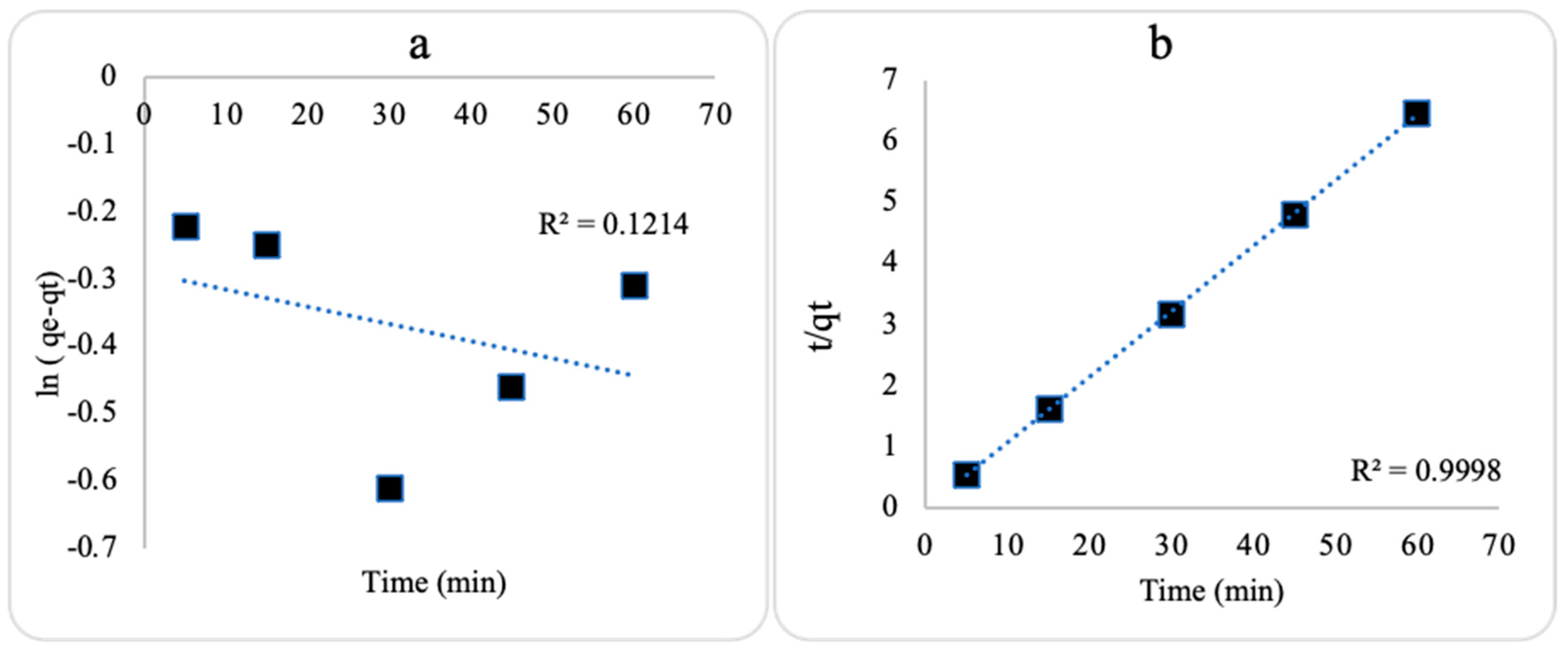



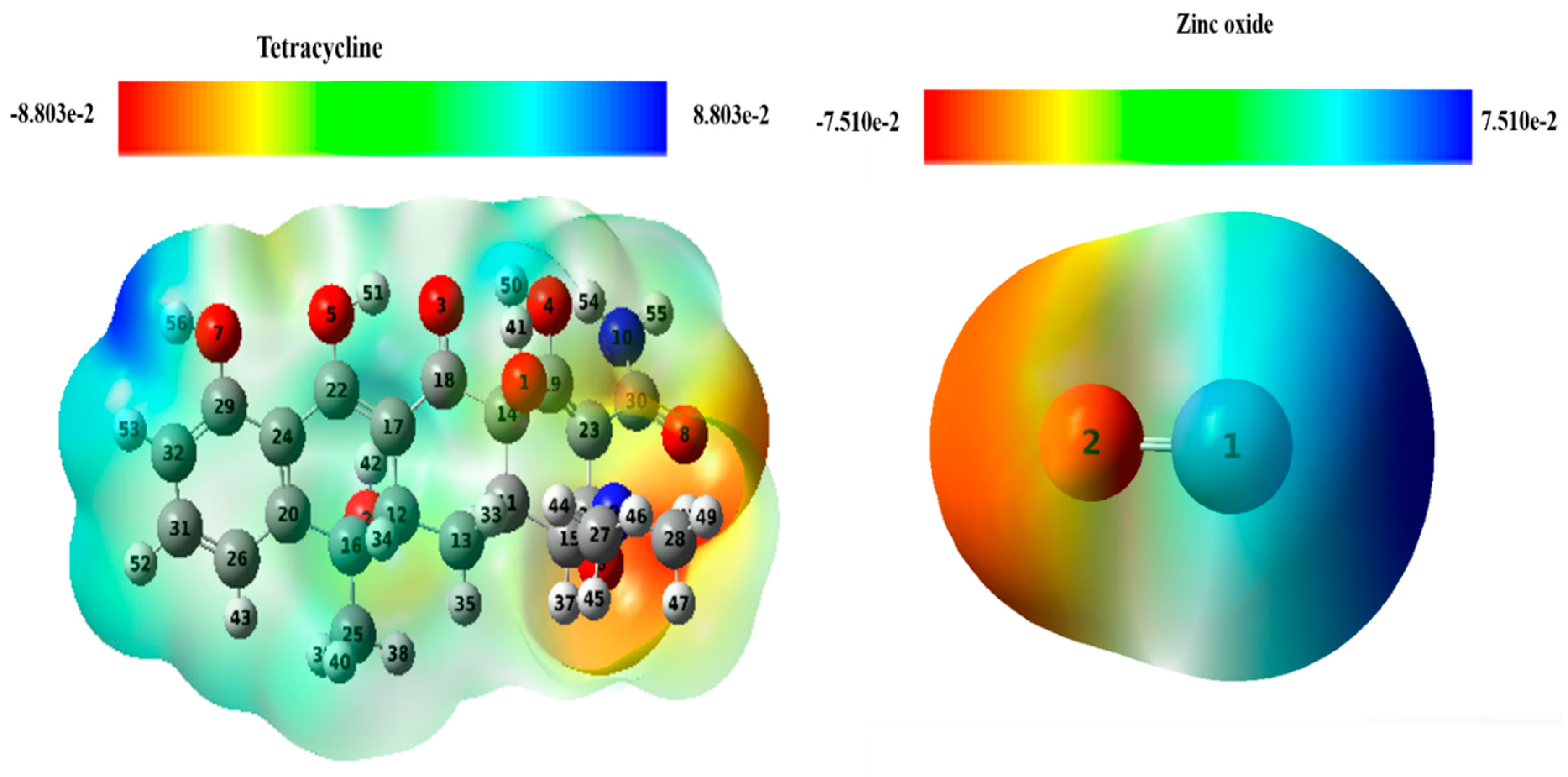
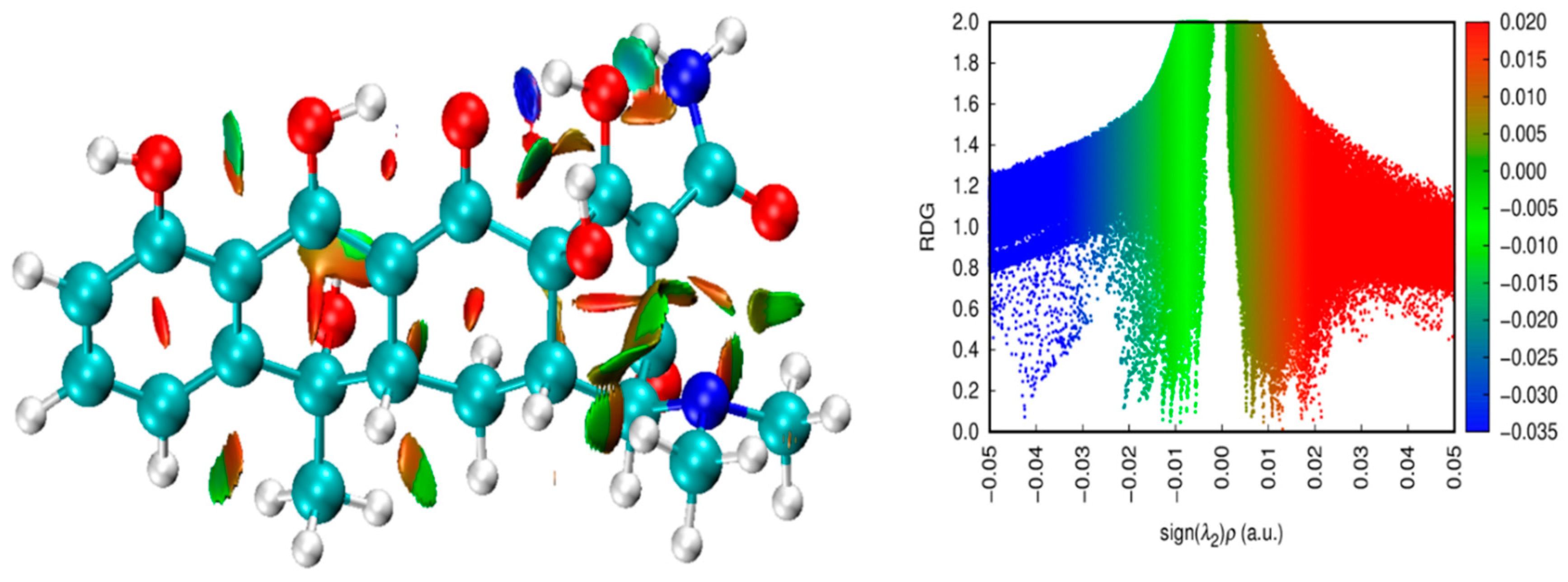
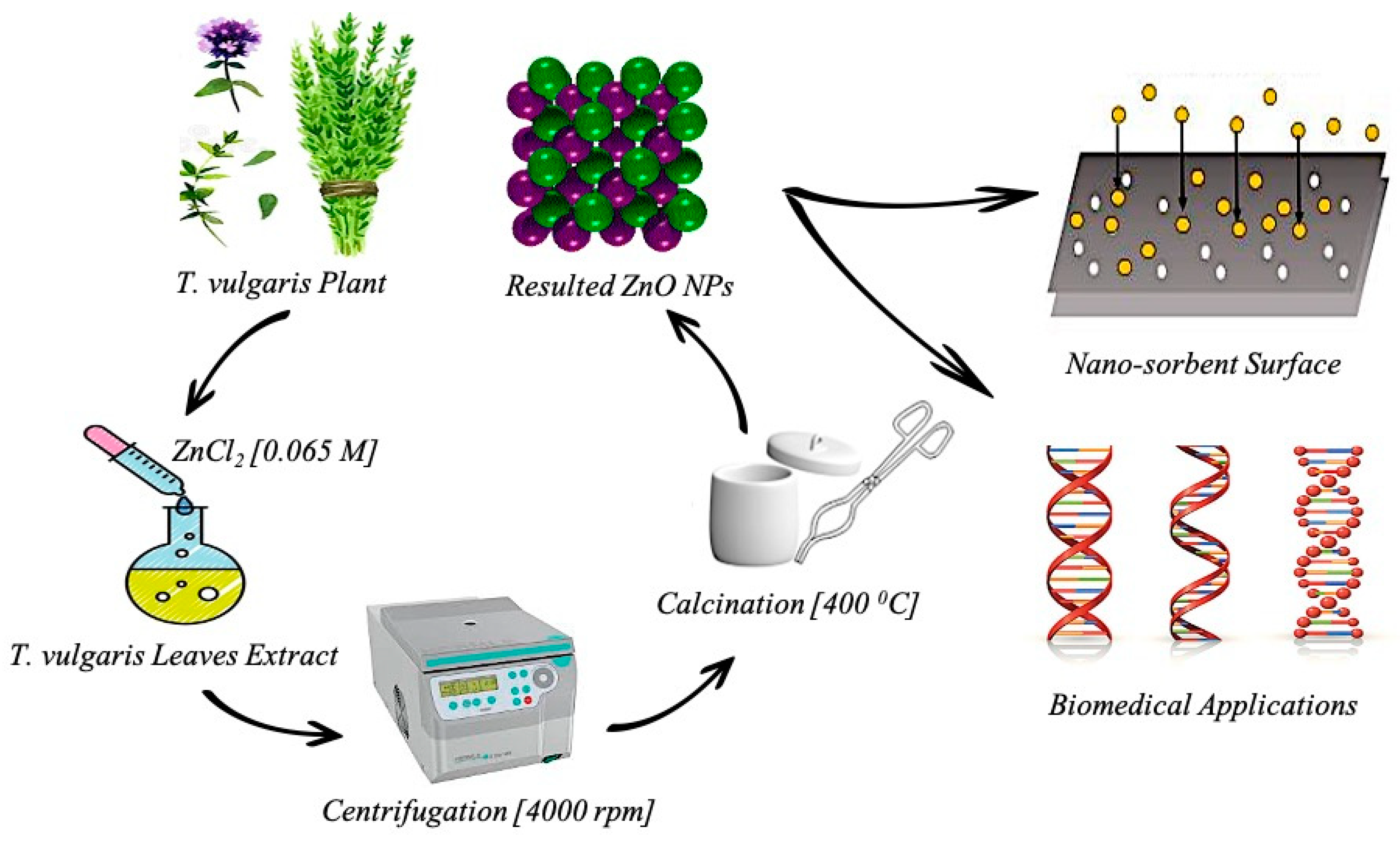
| Nanosorbent | ΔG° (KJ/mol) | △S° (1/KJ mol) | △H° (KJ/mol) |
|---|---|---|---|
| ZnO NPs | −6.42 | 23.79 | 0.55 |
| −6.74 | - | - | |
| −6.92 | - | - | |
| −7.06 | - | - | |
| −7.16 | - | - |
| Kinetic Model | Parameter | Nanosorbent |
|---|---|---|
| ZnO NPs | ||
| qe, exp (mg/g) | 41.840 | |
| Pseudo-1st order | qe, cal (mg/g) | 0.748 |
| k1 (1/min) | 0.000043 | |
| R2 | 0.121 | |
| Pseudo-2nd order | qe, cal (mg/g) | 9.302 |
| k2 (g/min.mg) | 1.628 | |
| R2 | 0.9998 |
| Isotherm Model | Parameter | Value |
|---|---|---|
| Langmuir | qm (mg/g) | 294.118 |
| KL (L/mg) | 0.037 | |
| RL (dimensionless) | 0.728 | |
| R2 | 0.514 | |
| Freundlich | KF (mg1−1/n·g−1·L−1/n) | 0.083 |
| 1/n | 1.1489 | |
| R2 | 0.840 | |
| Temkin | BT (J/mol) | 10.845 |
| KT (L/mg) | 2.260 | |
| R2 | 0.918 |
| Parameter | Tetracycline | Zinc Oxide |
|---|---|---|
| LUMO (eV) | −2.73 | −4.09 |
| HOMO (eV) | −5.50 | −6.63 |
| ) (Energy gap) (eV) | 2.77 | 2.53 |
| Ionization energy [I = −EHOMO]/eV | 2.73 | 4.09 |
| Electron Affinity [A = −ELUMO]/eV | 5.50 | 6.63 |
| Chemical Hardness η = (I − A)/2]/eV | −1.38 | −1.26 |
| Chemical Potential [u = −(I + A)/2]/eV | −4.11 | −5.36 |
| Softness of Molecule (s = I/2 η]/eV | −0.98 | −1.61 |
| Electronegativity [x = I + A)/2]/eV | 4.11 | 5.36 |
| Electrophilicity Index (ω = u2/2η]/eV | −6.11 | −11.33 |
Disclaimer/Publisher’s Note: The statements, opinions and data contained in all publications are solely those of the individual author(s) and contributor(s) and not of MDPI and/or the editor(s). MDPI and/or the editor(s) disclaim responsibility for any injury to people or property resulting from any ideas, methods, instructions or products referred to in the content. |
© 2024 by the authors. Licensee MDPI, Basel, Switzerland. This article is an open access article distributed under the terms and conditions of the Creative Commons Attribution (CC BY) license (https://creativecommons.org/licenses/by/4.0/).
Share and Cite
Alshahateet, S.F.; Al-Trawneh, S.A.; Er-rajy, M.; Zerrouk, M.; Azzaoui, K.; Al-Tawarh, W.M.; Hammouti, B.; Salghi, R.; Sabbahi, R.; Alanazi, M.M.; et al. Green Synthesis of Zinc Oxide Nanoparticles for Tetracycline Adsorption: Experimental Insights and DFT Study. Plants 2024, 13, 3386. https://doi.org/10.3390/plants13233386
Alshahateet SF, Al-Trawneh SA, Er-rajy M, Zerrouk M, Azzaoui K, Al-Tawarh WM, Hammouti B, Salghi R, Sabbahi R, Alanazi MM, et al. Green Synthesis of Zinc Oxide Nanoparticles for Tetracycline Adsorption: Experimental Insights and DFT Study. Plants. 2024; 13(23):3386. https://doi.org/10.3390/plants13233386
Chicago/Turabian StyleAlshahateet, Solhe F., Salah A. Al-Trawneh, Mohammed Er-rajy, Mohammed Zerrouk, Khalil Azzaoui, Waad M. Al-Tawarh, Belkheir Hammouti, Rachid Salghi, Rachid Sabbahi, Mohammed M. Alanazi, and et al. 2024. "Green Synthesis of Zinc Oxide Nanoparticles for Tetracycline Adsorption: Experimental Insights and DFT Study" Plants 13, no. 23: 3386. https://doi.org/10.3390/plants13233386
APA StyleAlshahateet, S. F., Al-Trawneh, S. A., Er-rajy, M., Zerrouk, M., Azzaoui, K., Al-Tawarh, W. M., Hammouti, B., Salghi, R., Sabbahi, R., Alanazi, M. M., & Rhazi, L. (2024). Green Synthesis of Zinc Oxide Nanoparticles for Tetracycline Adsorption: Experimental Insights and DFT Study. Plants, 13(23), 3386. https://doi.org/10.3390/plants13233386











